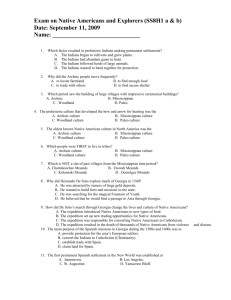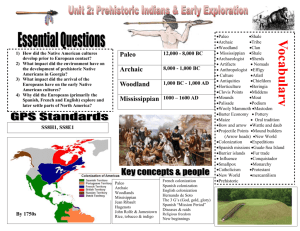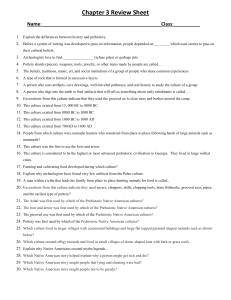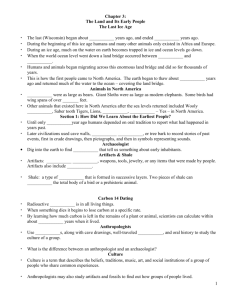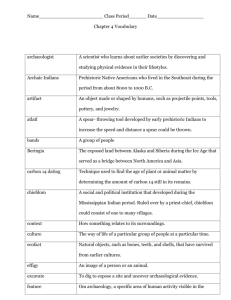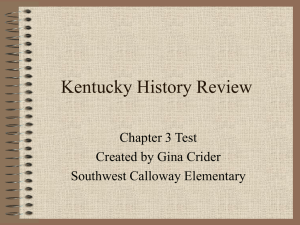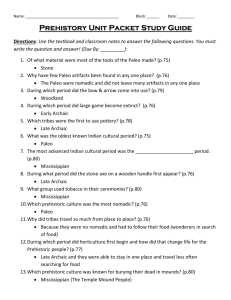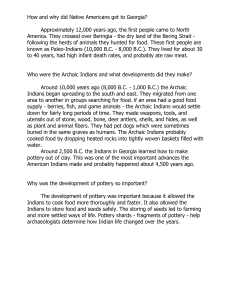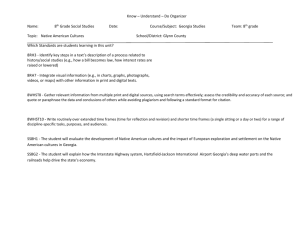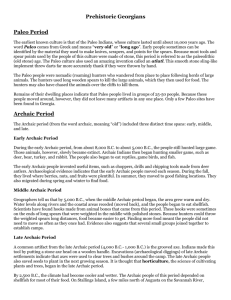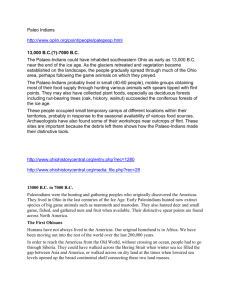Native American Study Guide
advertisement
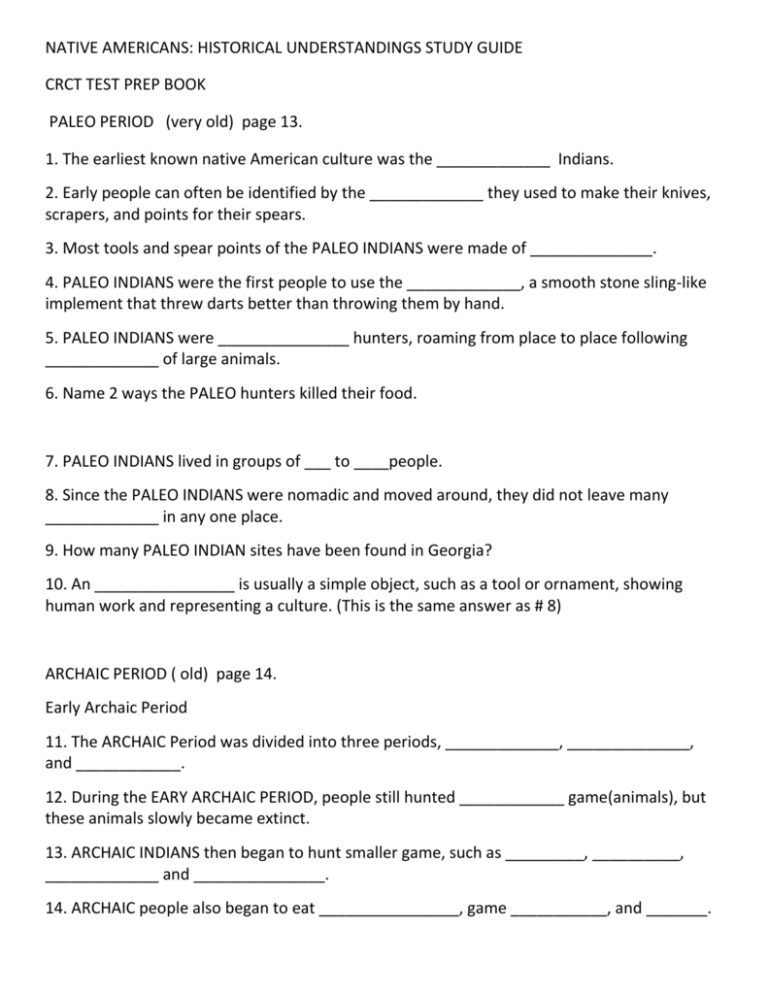
NATIVE AMERICANS: HISTORICAL UNDERSTANDINGS STUDY GUIDE CRCT TEST PREP BOOK PALEO PERIOD (very old) page 13. 1. The earliest known native American culture was the _____________ Indians. 2. Early people can often be identified by the _____________ they used to make their knives, scrapers, and points for their spears. 3. Most tools and spear points of the PALEO INDIANS were made of ______________. 4. PALEO INDIANS were the first people to use the _____________, a smooth stone sling-like implement that threw darts better than throwing them by hand. 5. PALEO INDIANS were _______________ hunters, roaming from place to place following _____________ of large animals. 6. Name 2 ways the PALEO hunters killed their food. 7. PALEO INDIANS lived in groups of ___ to ____people. 8. Since the PALEO INDIANS were nomadic and moved around, they did not leave many _____________ in any one place. 9. How many PALEO INDIAN sites have been found in Georgia? 10. An ________________ is usually a simple object, such as a tool or ornament, showing human work and representing a culture. (This is the same answer as # 8) ARCHAIC PERIOD ( old) page 14. Early Archaic Period 11. The ARCHAIC Period was divided into three periods, _____________, ______________, and ____________. 12. During the EARY ARCHAIC PERIOD, people still hunted ____________ game(animals), but these animals slowly became extinct. 13. ARCHAIC INDIANS then began to hunt smaller game, such as _________, __________, _____________ and _______________. 14. ARCHAIC people also began to eat ________________, game ___________, and _______. 15. The early ARCHAIC people invented useful items, such as _______________, ___________, and ________________ ______________ made from deer ____________. 16. Early Archaic people moved each _______________. 17. In the fall, they lived where _____________, ____________ and _______ were found. 18. In summer, they moved to where good _________________ was found. 19. In spring and winter they ________________ (moved) to find food. Middle Archaic Period 20. By the Middle ARCHAIC period, water levels along rivers and coastal areas receded (moved back) and the area grew ____________ and ________. 21. ARCHAIC people then began to eat ___________. 22. _____________made from animal bones have been found on weighted spears. 23. Weighted spears could be thrown longer distances so ____________ became easier to get. 24. Finding more food meant that the people did not have to ___________ as often as they once had. 25. It has been discovered that several small groups now joined together to establish _____________. Late Archaic Period 26. A common artifact from the Late ARCHAIC period is the ______________ ________, made by putting an axe head on a wooden handle. 27. What are excavations? 28. It has been indicated that these axes were used to clear ________ and __________ around the Indian camps. 29. Late ARCHAIC INDIANS saved ___________ to plant and it is thought that ____________________, the science of cultivating plants and trees began in this period. 30. Archaeologists digging on Stallings Island, on the Savannah River, found large mounds of _______________ and _________ shells. 31. Also on Stallings Island were the remains of _____________ grounds, ___________ hearths, ___________, _____________, shell ____________, ___________ pins and _____________, bone _____________ and many different ____________points. 32. Because of these discoveries on Stallings Island, historians believe Late ARCHAIC villages were more _________________ than any other group before them. 33. The way __________ was prepared also changed during the Late ARCHAIC period. 34. POTTERY SHARDS ( pieces of pottery) were discovered which indicate that __________ containers were used for storing, cooking, and serving food in the ARCHIAC period. 35. Learning to make and use ________________ may be one of the greatest contributions the ARCHAIC people made to Native American culture. WOODLAND PERIOD page 15-16 36. During the WOODLAND Period several hundred families began banding together to form _______________. 37. A ______________ is a group of people who share a common ancestry, name, and way of living. 38. The WOODLAND tribes lived together in _______________ and built dome-shaped houses called _________, which were made from small trees and bark. 39. Woodland Indians made hunting easier when they developed the _______ and _________. 40. Arrow points were made out of ____________, _____________ teeth, or deer _______________. 41. Important ways of getting food for WOODLAND Indians was also ________________, _______________, and gathering _________ and ___________. 42. WOODLAND people also grew things such as ____________, wild ____________, and ____________________. 43. WOODLAND people made pottery last longer by mixing clay with _____________. 44. Name the 2 steps used to make clay containers hard enough to use for cooking. 45. Elaborate ________________ ceremonies were introduced during the WOODLAND period. 46. WOODLAND INDIANS were the first to build cone-shaped _______________ mounds for their dead. 47. When WOODLAND people were buried, their bodies were adorned with ______________ , _______________, ____________, and copper or bone _____________ and the families and friends of the dead person put pottery, tools, tobacco pipes and _________________ in the grave with them. 48. Archaeologists think that prehistoric Indians believed in some form of ___________ after __________ because of the artifacts found in the burial mounds. MISSISSIPPIAN PERIOD page 16. 49. The ___________________________ culture is the youngest and most civilized of the prehistoric civilizations found in Georgia. 50. The first things learned about the MISSISSIPPIAN INDIANS were from villages excavated along the _______________ River. 51. MISSISSIPPIAN INDIANS planted __________ (corn), __________, _________________, and ______________ together in hills. 52. MISSISSIPPIAN INDIANS planted _______________ to use in ceremonies, and they planted in different fields each year so the soil would stay ___________. 53. MISSISSIPPIAN INDIANS began to dress differently, their _______________ were less simple and they wore ______________ and ______ ornaments. 54. MISSISSIPPIAN INDIANS painted or _________________ their bodies and began wearing _________________ headdresses. 55. During the MISSISSIPPIAN Period, villages grew and several ___________________ families might live in a single settlement. 56. MISSISSIPPIANS built centers for _________________ ceremonies and often built __________ and ____________________ ( wooden fences) to protect the villages. 57. In some Georgia villages, _____________ _______________ have been found along the palisades, (wooden fences) indicating that they needed to defend themselves against tribal _____________. 58. What happened to the MISSISSIPPIAN INDIANS?
